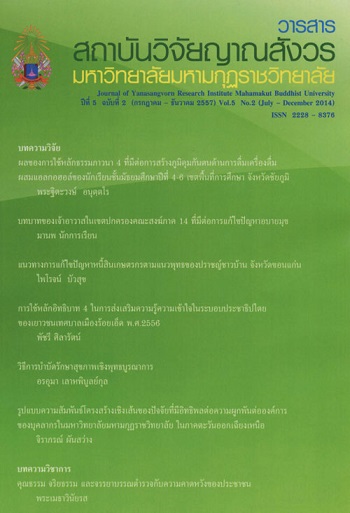The Method of Buddhist Health Treatment in Integrated Approach
Main Article Content
Abstract
The research report are of three objectives, namely: to study the health healing in modern in Buddhism and to integrate the health healing of both methods. The research methodology is the documentary qualitative by studying from the Tipitaka and the relevant documents. The results show that the modern health treatment is the care through the medical instruments. It decided to conquer the diseases with medicine and medical scientific instruments. It is the separate healing between physics and the mentality. The Buddhist health treatment is emphasized on both physical and mental healing naturally. It needs to use medicine, food and nurses. To heal physical diseases must based on the appearance and the causes of decease. However, Buddhism emphasizes the mental healing through the practice of both the tranquillized meditation and the insight one. In term of protecting the coming decease, it is the exercise by having food with full nutrition, cleaning the house, clothes and conserving the environment. The integrating of health in Buddhist approach is to use the modern scientific instruments to check diseases in all dimensions of decease causes, i.e., temperature, food, mind and Kamma. In using the modern medical instruments, one must think of the patient’s feeling and kindly use to the patients as well. In the sense of mental illness, one must realize the pain according to the Buddhist perspective. The medicine must be used carefully owing to the fact that the modern medicine chemically affected the body. Some deceases are of no need for using the medicine. Physical healing is to integrate both the modern heath science and Buddhist perspective by projection, the injection, the operation, the medicine taking, the heaping, and the vanishing, it should be of the adding of the sauna, and the nose smoking including the practice of meditation. The aim of healing is not only to cure the patients, but also to make the patients understand rightly about the pain. It is not to emphasize the destroying of the deceases with the health science instruments and the medicine. It should heal as the holistic care, both of physical and mental aspects. The good aim of healing is to protect the physical and the mental health to be strong.
Article Details
References
จำลอง ดิษยวณิช, ผศ. นพ. จิตวิทยาของความดับทุกข์. เชียงใหม่. : กลางเวียงการพิมพ์, ๒๕๔๔.
ประเวศ วะสี (ศ.น.พ.). การปรับทรรศนะทางการแพทย์และสาธารณสุข. กรุงเทพมหานคร : หมอชาวบ้าน, ๒๕๓๓.
__________.องค์รวมแห่งสุขภาพ : ทัศนะใหม่เพื่อดุลยภาพและการบำบัดรักษา. กรุงเทพฯ : สำนักพิมพ์มูลนิธิโกมลคีมทอง, ๒๕๓๖.
เค็นเน็ธ จี ซิสค์. ลัทธินักพรตและการเยียวยาในอินเดียโบราณ : ระบบการแพทย์ในพุทธอาราม แปลโดย ธีรเดช อุทัยวิทยารัตน์, พิมพ์ครั้งที่๒. กรุงเทพมหานคร : มูลนิธิโกมลคีมทอง, 2552.
พระธรรมปิฎก (ป.อ. ปยุตฺโต). การแพทย์ยุคใหม่ในพุทธทัศน์. พิมพ์ครั้งที่ ๒. กรุงเทพมหานคร: กองทุนวุฒิธรรม เพื่อการศึกษาและปฏิบัติธรรม, ๒๕๔๒.
วลัยพร ภวภูตานนท์ ณ มหาสารคาม, “บทบาทของพระสงฆ์ไทยที่เป็นหมอพระในด้านการบำบัดรักษาโรคแก่ชุมชน” รายงานการวิจัย,กรุงเทพฯ : ภาควิชามนุษยศาสตร์ คณะสังคมศาสตร์และมนุษยศาสตร์ มหาวิทยาลัยมหิดล, 2521.


